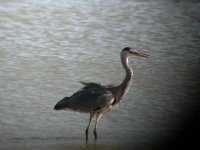I had my first go at 'proper' digiscoping yesterday at Rutland Water. As expected most of the images as only fit for the bin, but a couple of problems that I need some help with cropped up.
Equipment is Kowa 822 scope with 20x60 zoom - straight scope, non HD glass.
Camera is Coolpix 4500 with Eagle eye adaptor.
Firstly, some of the images show vignetting down the right hand side only- see attached heron picture. It was clearly visable on the LCD screen and could only be cured by taking the zoom to its longest setting. The adaptor was square on the eyepiece and pushed in as far as it would go. This problem only affected some of the pictures. The rest of the time the LCD screen was clear of vignetting at mid zoom settings.
Secondly, a lot of pictures are suffering from highlight burnout. I was using the spot metering in the camera and I would expect some over expouse of the backgrounds, but the effect seems a bit extreme. Should I be changing settings on the camera to compensate?
Sorry to go on at such length, but any help will be much appreciated.
AndyC
Equipment is Kowa 822 scope with 20x60 zoom - straight scope, non HD glass.
Camera is Coolpix 4500 with Eagle eye adaptor.
Firstly, some of the images show vignetting down the right hand side only- see attached heron picture. It was clearly visable on the LCD screen and could only be cured by taking the zoom to its longest setting. The adaptor was square on the eyepiece and pushed in as far as it would go. This problem only affected some of the pictures. The rest of the time the LCD screen was clear of vignetting at mid zoom settings.
Secondly, a lot of pictures are suffering from highlight burnout. I was using the spot metering in the camera and I would expect some over expouse of the backgrounds, but the effect seems a bit extreme. Should I be changing settings on the camera to compensate?
Sorry to go on at such length, but any help will be much appreciated.
AndyC




